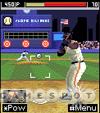Barry Bonds Homerun History, the new home run derby game from Mforma and Gamevil, uses a very similar batting engine to that included in CBS Sportsline Baseball 2004, the duo's last baseball outing. These easy offensive mechanics, combined with Homerun History's range of competitive options, add up to a fun arcade baseball game, even if the scope of gameplay is extremely limited.

Barry Bonds Homerun History puts you in the shoes of San Francisco's famous, latter-day slugger as he lumbers toward Major League Baseball's all-time homerun record. In actuality, Homerun History lets you go for several different goals in "countdown to 756" mode, including beating Willy Mays' single-season record, besting Babe Ruth at his own power-hitting game, and finally just blasting as many dingers as you can in 99 pitches. Each of the four goals gets sequentially more difficult, as you have to hit a higher number of homers in a smaller number of pitches. Alternately, you can also guide Barry through showdown mode, where he and four rival batters each race to 20 homers, switching off every three pitches.
Homerun History plays much the same in either instance. You get a behind-the-plate view of Bonds as he straddles home, waiting to chew the opposing pitcher to pieces. The only real control you have over number 25 is when he swings the bat and in which general section of the bleachers he aims for. The 4, 5, and 6 keys hit to the left, center, and right part of the screen, respectively. In countdown mode, Barry also receives a limited number of power shots, which you can use to supercharge his already potent swing. You can replenish these power shots by hitting certain bull's-eye targets in the crowd with your homers--and also gain extra pitches, if you're lucky enough to nail the giant 756 that's perched in the lower deck.
These arcade elements aren't much, but they add a modicum of depth to the otherwise extremely lightweight gameplay. All you need to do to hit a homer in Homerun History is time your swing correctly. It doesn't seem to matter which direction you aim or where the ball enters the strike zone; if you don't hit the ball 380 feet or so, it's a failed pitch, whether you miss the pitch entirely or simply fail to reach the necessary distance threshold. Compared to games like Sorrent's Batter Up!, which sports a much more complex pitching, batting, and scoring system, there's simply not that much to do at the plate in Homerun History.
On the other hand, homerun derby games conventionally put fun before detail and intricate design, and Homerun History's myriad arcade touches insure that even your single, repetitive gameplay experience is an enjoyable one. There's a meter at the top of the screen that measures how many pitches you have left versus how many homers you need (or, in showdown mode, your and your opponent's relative progress toward 20 homers). This meter lets you tell at a glance what kind of pace you're setting, and it helps add to the pressure if you're falling behind. In addition, the game keeps track of how many homers you've hit in a row, adding to your combo score as you thwack one ball after another into the stands. Once you get the correct rhythm down, it's fun to concentrate and try to get on the biggest roll you can muster. The power-up system is kind of interesting as well. Using a power-up and then connecting on a pitch virtually guarantees a massive homer (all the way out to 700 feet), allowing you to ration your power-ups for a little boost toward the end of the contest, if necessary. In the showdown mode, Barry and his opponent trade verbal jabs as they switch places at the plate; the better Barry's doing, the jauntier his ripostes become, and vice versa. These minutiae help to fill out Homerun History's core gameplay.

Homerun History's graphics are pretty good on Nokia Series 60 handsets, but far from unprecedented. Many of the sprites are related to those used in CBS SportsLine Baseball 2004, and the batters and pitchers suffer from a similar lack of animation. The outfielders are completely static (although they are also irrelevant to gameplay). On the other hand, the game's graphics are very detailed, and the camera pans quickly and realistically to follow homers into the stands. Also, if you hit a homer in exactly the right spot, a little animation will play off your ball, making a splash in what is presumably the San Francisco Bay. Homerun History's sound is alright, and it features brief effects for successful hits and homeruns. Unfortunately, it also makes the game's frame rate crawl for some reason, so you'll get a much better play experience by turning it off.
In all, Barry Bonds Homerun History gets a surprising amount of entertainment out of its relatively skimpy gameplay, thanks to a slick, highly playable implementation. Three difficulty levels and eight playable scenarios make for a fair amount of slugging. The game also keeps track of your all-time records for consecutive and total homeruns. Although Homerun History plays like a fancy minigame next to Batter Up!, baseball fans looking for a pleasantly facile play will get some value out of Barry Bonds' quest for the record.